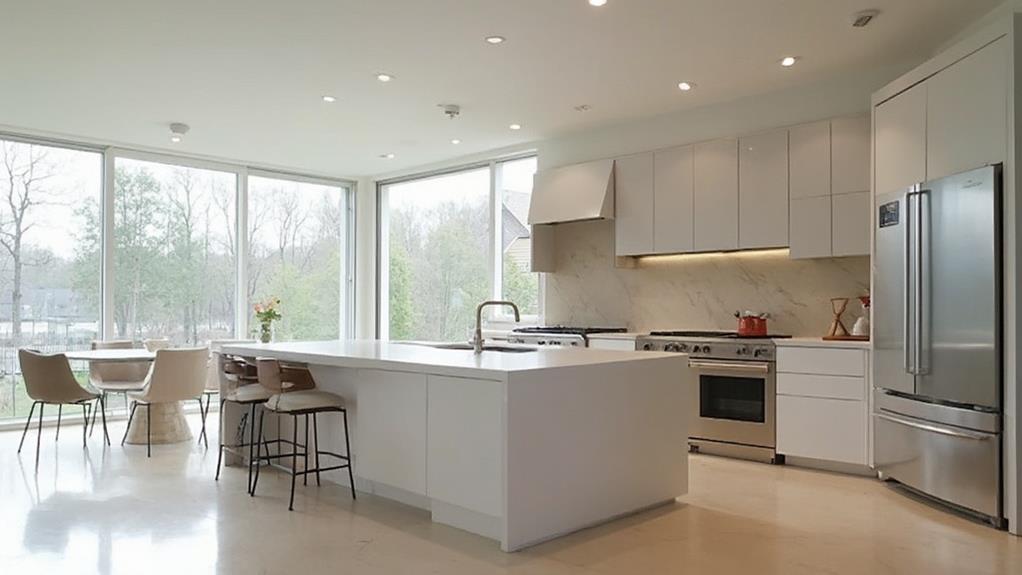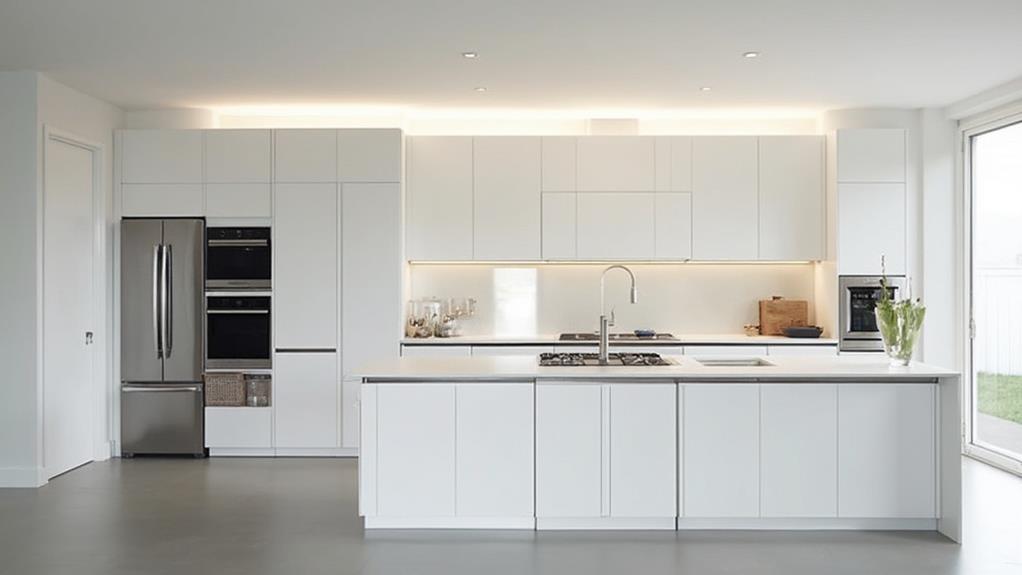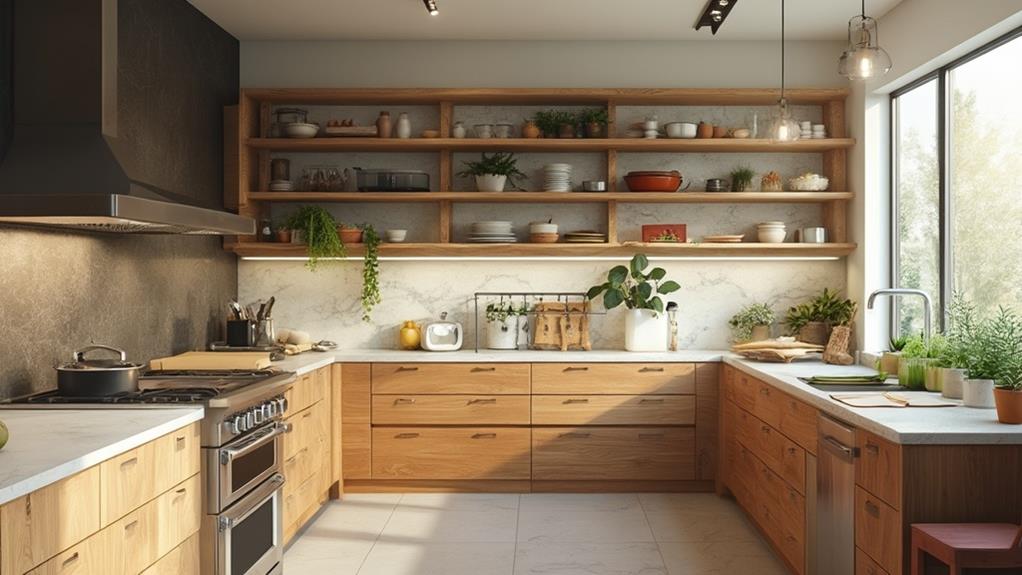To design a kitchen that balances form and function, start with an efficient layout like a work triangle or U-shaped design. Choose durable materials like granite or quartz for countertops and solid wood for cabinetry. Maximize storage with pull-out shelves, drawer dividers, and vertical organizers. Incorporate layered lighting with ambient, task, and accent options. Integrate appliances strategically, considering built-in options for a sleek look. Create harmony through a cohesive color scheme and mix of textures. Don't forget to prioritize ergonomics and workflow in your design. By following these principles, you'll create a kitchen that's both beautiful and practical. The details that follow will help you refine your vision even further.
Layout and Flow

Crafting an efficient kitchen layout begins with understanding the essential work triangle. This concept connects your three primary work areas: the refrigerator, sink, and stove. You'll want to keep these points within 4 to 9 feet of each other, forming a triangle that allows for smooth movement and easy access.
Consider your kitchen's shape when planning the layout. U-shaped kitchens offer ample counter space and storage, while L-shaped designs work well in smaller areas. Galley kitchens are ideal for narrow spaces, maximizing efficiency in a linear layout. If you have room, an island can provide extra workspace and storage while serving as a focal point.
Don't forget about traffic flow. Ensure there's enough space between counters and appliances for multiple people to move comfortably. You'll want at least 36 inches of clearance for walkways and 42 inches for work aisles.
Organize your kitchen into zones: food storage, food prep, cooking, and cleaning. This approach streamlines your workflow and keeps everything you need within easy reach. By carefully considering layout and flow, you'll create a kitchen that's both functional and enjoyable to use.
Material Selection
How do you choose the right materials for your kitchen? Start by considering durability, maintenance, and aesthetics. For countertops, granite offers timeless appeal and resilience, while quartz provides a non-porous, low-maintenance alternative. Butcher block adds warmth but requires regular upkeep.
For flooring, porcelain tiles resist stains and moisture, while hardwood brings natural beauty but may be prone to water damage.
When selecting cabinetry, solid wood offers longevity and customization options, but engineered wood can be more budget-friendly and resistant to warping. For hardware, stainless steel resists corrosion and matches modern appliances, while brass or copper add a vintage touch.
For backsplashes, ceramic tiles offer endless design possibilities and easy cleaning, while glass tiles create a sleek, reflective surface. Natural stone adds texture but requires sealing. Consider the sink material carefully: stainless steel is durable and affordable, while fireclay or cast iron sinks provide a distinctive look but may be heavier and more expensive.
Remember to balance your material choices with your kitchen's overall style, your budget, and your willingness to maintain each surface. The right combination will create a cohesive, functional, and visually appealing kitchen.
Storage Solutions

Every efficient kitchen relies on smart storage solutions. You'll want to maximize every inch of space while keeping essentials easily accessible. Start by assessing your needs and habits.
Consider pull-out pantry shelves for deep cabinets, making it easy to reach items at the back. Install drawer dividers for utensils and cooking tools to keep them organized and prevent clutter.
Vertical space is often underutilized. Add hooks under cabinets for mugs or install a magnetic knife strip on the wall. Use the inside of cabinet doors for spice racks or mounting cutting boards. Don't forget about corner cabinets; lazy Susans or pull-out shelves can make these tricky spaces more functional.
For smaller kitchens, think creatively. A rolling cart can provide extra counter space and storage. Wall-mounted shelves or a pot rack can free up cabinet space. If you have high ceilings, consider adding a second row of cabinets for rarely used items. Remember, the key to effective storage is customization. Tailor your solutions to fit your specific needs and kitchen layout for the best results.
Lighting Design
While storage keeps your kitchen organized, proper lighting brings it to life. You'll want to incorporate a layered lighting approach, combining ambient, task, and accent lighting to create a functional and inviting space.
For ambient lighting, consider recessed ceiling lights or a central pendant fixture to provide overall illumination. Task lighting is crucial for food preparation areas; install under-cabinet LED strips or adjustable pendant lights above islands and countertops. Don't forget accent lighting to highlight architectural features or display areas.
Choose bulbs with the right color temperature; warm white (2700-3000K) creates a cozy atmosphere, while cool white (3500-4100K) enhances visibility for task areas. Dimmer switches allow you to adjust light levels for different times of day or activities.
Consider natural light sources as well. If possible, maximize window placement to bring in sunlight during the day. Skylights or light tubes can brighten dark corners and reduce reliance on artificial lighting.
Remember to plan your lighting layout early in the design process to ensure proper electrical wiring and placement. With thoughtful lighting design, you'll create a kitchen that's both functional and visually appealing.
Appliance Integration

The heart of any kitchen lies in its appliances. When integrating these essential tools into your kitchen design, you'll need to consider both functionality and aesthetics.
Start by determining which appliances you'll use most frequently and prioritize their placement accordingly. For instance, position your refrigerator near the entrance for easy access, and place your dishwasher close to the sink for efficient cleanup.
Consider the work triangle concept, which connects your cooktop, sink, and refrigerator. This layout minimizes unnecessary movement and maximizes efficiency. Built-in appliances can create a sleek, cohesive look, while freestanding options offer more flexibility.
Don't forget about smaller appliances like microwaves, coffee makers, and toasters – plan for dedicated spaces or hidden storage to keep countertops clutter-free.
Energy efficiency is another crucial factor. Opt for ENERGY STAR certified appliances to reduce your environmental impact and lower utility bills.
Color and Texture Harmony
Beyond the practicalities of appliance placement, your kitchen's visual appeal hinges on color and texture harmony. To create a cohesive look, start by selecting a primary color for your cabinets or walls. This will set the tone for the entire space. Then, choose complementary or contrasting colors for countertops, backsplashes, and flooring.
Consider the mood you want to evoke. Warm colors like reds and yellows can create a cozy atmosphere, while cool blues and greens promote calm. Neutral tones offer versatility and timelessness. Don't forget about texture – it adds depth and interest to your kitchen. Mix smooth surfaces with rough ones, like glossy cabinets paired with a textured backsplash.
When selecting materials, think about how they'll work together. Wood grain can add warmth, while stainless steel provides a modern touch. Granite or quartz countertops offer durability and visual appeal. Remember to balance your choices – too many competing textures or colors can overwhelm the space. Use accent pieces sparingly to add pops of color or unique textures without cluttering the overall design. By carefully considering color and texture, you'll create a harmonious kitchen that's both visually striking and functional.
Conclusion
As you finalize your kitchen design, remember that balancing form and function is like choreographing a dance – every element must move in harmony. You've considered layout, materials, storage, lighting, appliances, and aesthetics. Now, step back and ensure it all flows together seamlessly. Your kitchen should be a reflection of your style while effortlessly supporting your culinary needs. With careful planning, you'll create a space that's both beautiful and practical for years to come.

